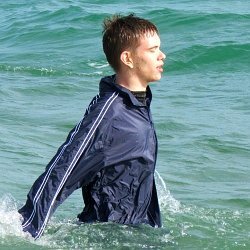🌊 Open Water Survival Lesson Plan
Here's a fun and engaging lesson plan for open water survival swimming. We'll focus on building essential skills to stay safe in aquatic environments while fully clothed. Remember, safety first!
In this engaging session, we'll dive into essential skills for staying safe in open water. We swim in clothes for a more intense and realistic workout. Whether you're at the beach, by a river, or near a lake, these survival techniques could be lifesavers. Let's jump right in!
Objective
To prepare students for an aquatic emergency in open water,
combining survival swimming skills and water safety knowledge to avoid danger and respond effectively if needed.
Core Skills and Knowledge
- Identify hazards in various aquatic environments (pools, beaches, rivers, and lakes)
- Enter and exit the water safely (slide in and climb out)
- Walk in and out of water, observe obstacles
- Move through the water confidently
- Practice various swimming strokes while fully clothed
- Practice survival moves to propel away from danger
- Submerge comfortably
- Underwater movements (submersion, turning, and rotating bubbles)


Activities
Emergency Role Play (10 minutes)
- Scenario: You're at the beach and want to swim. Discuss where to swim safely.
- Must-See Tips:
- Always swim between the red and yellow flags (where lifeguards can see you).
- Stay in shallow water.
- Never swim alone.
- Turn your back to the wave as it splashes.
- Encourage students to practice survival strokes without goggles (real-life simulation).
- Practice various survival strokes with a relaxed body position.
- Identify hazards in different aquatic settings (e.g., strong currents, submerged objects).
- Discuss strategies to avoid or respond to each hazard.
- Combine survival strokes (e.g., doggy paddle, sidestroke) to move away from danger.
- Emphasize calmness and efficient movement.
- Question: Where should you always swim at the beach?
- Answer: Between the red and yellow flags (discuss flag setup).
Keep Warm
Your clothing protects you from wind, sunburn, cuts and bruises. Which clothes you'll need depends on the weather and what sport you're training for, unless you swim in clothes just for fun.
Dress for immersion, not the air temperature. Clothes are meant to keep you warm. This also holds true in the water, up to a point. T-shirt, jeans and hoodie might be fun for resistance swim training, but cotton can seriously chill you out over time. It holds on to a lot of water which cools you as it evaporates.
Functional fibres like fleece keep you warm even when wet.
You're more comfortable in the water when you dress warm enough in comfy clothes.
Open Water Swimming Kit
Survival swimming clothes protect you in open water and on the beach against rocks, pebbles, sunburn and wind chill. Wear at least the outer layer, just to be safe.
Be Visible
Bright coloured swimming clothes and a hat or hood can be seen by fast moving traffic. Lifeguard uniforms are easy to swim in as they are designed to be worn for water rescues.
Swim with whatever whatever clothes you feel comfortable in. Just make sure they fit well and don't interfere with your swimming ability. Gain experience by swimming in different types of clothes like tee-shirt, sweatshirt, trousers or jeans, anorak or windproof rain suit.
Waterproof clothes are the most practical outfit as they dry quickly, don't weigh much and protect you from wind chill. Depending on their design they hold more or less water when swimming. You can find all sorts of robust and inexpensive training gear in army surplus stores.
Some swimmers like to wear boots or socks, neoprene balaclava hats and wet suits,
especially in colder weather if they want to spend more time in the water.
Swimmers should bring three unlined clothing layers (base, middle, outer),
as used in canoeing, coasteering, sailing or other adventure sports.
High visibility clothes would be an advantage.
Always start a session in dry kit. If you plan several swimming sessions, you need need a bit more gear as it is not nice to put on clammy cold clothes after a warm-up break. Remember to bring a change of dry clothes for your way home.
The following equipment is needed by each swimmer for proper survival swimming sessions.
This will get wet:
- T-shirts (long and short sleeves)
- Hoodie, sweatshirt or pullover
- Trousers, cargo pants or jeans
- Anorak and rain pants, or coverall
- Trainers or sports shoes and socks
- Poncho as shelter and changing room
- Sleeping mat as float and for sitting on
- A large beach towel
- Plenty to eat and drink
- Sleeping bag and mat (mission-dependent)
- Dry clothes and shoes to change into afterwards
- Rucksack with three large heavy-duty plastic bags
(for food, spare clothing and sleeping bag)
Full Survival Gear
You should wear full gear during training and testing unless otherwise instructed. "Full gear" means two long sleeve tops, trousers, socks and boots, and a helmet where required.
A waterproofed rucksack can be used as a flotation device.
A sleeping bag and sleeping mat should be externally attached to the rucksack
in a way that it stays dry, but is optional, depending of your training objectives.